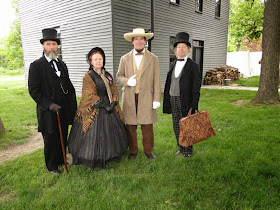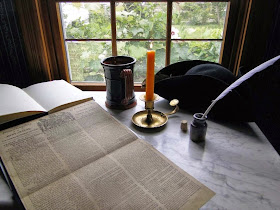And for the most part, the majority of us who practice authentic living history do a pretty darned good job in the period clothing department. Oh, there may be a few disagreements about "who wore what," and some of the unnecessary nit-pickiness that even our ancestors would scoff at, but generally, most of us could be placed in the past and pass as a local.
However, reenactors cannot live on clothing alone - - the past will still be dead without the proper accessories to help bring it to life. For instance, if you have a young lady in a hoop skirt posing next to a modern automobile, it looks kind of silly, doesn't it?
 |
| You can take the girl out of the 19th century, but you can't take the 19th century out of the girl! Or is it vice-versa? Ha! |
Or give a group of period dress living historians modern items and, well, something just doesn't seem right...they even act differently!
 |
| Little Caesar's Pizza, Coca Cola, and (plastic) bottled water - well...if they'da had it, they'da ate and drank it, right? |
Now, surround some of these same reenactors with period-correct accessories - items that are very important in bringing a visitor into the world of the past that are too often left by the way side - and not only do they no longer look silly, but they, instead, seem like are actually from the past!
It's pretty obvious that surroundings and accessories will make a difference. Period clothing does very little without accessories to enhance the presentation, and accessories can be bland and boring with little meaning without a period-dressed person to make them come alive. Imagine seeing a cider press in a museum but not seeing it in action. Like a husband & wife or peanut butter & jelly or Ken & American history, period clothing & accessories go hand-in-hand with each other.
Over the years I have acquired numerous past products to display or demonstrate to the public. I'd like to show you a few of the ones I've been using to help bring the past to life. I don't bring everything to every event, by the way. Just what I feel I would like to have or maybe need depending on where I'm at.
I'd like to begin with the things that have greatly enhanced my Civil War era impression, followed by a few of the Colonial items I have, and show first my earliest impression as a reenactor - the Post master. It's what got me going as a presenter during reenactments and eventually allowed me to branch out beyond letters and mail delivery to talking about taverns, stagecoach stops & travel, and general stores:
 |
| Here is my Post Office set up, including the dovecote-style mail sorter, which is based on an original from the 19th century. Whether I set up as a post master inside a post office, speak about tavern life, show a stage coach stop, or even present as a general store owner, this set up will work in any of those scenarios, for mail was picked up and delivered at all four places. |
 |
| Dipping
candles is a great presentation for the younger set----yes, they still made
candles in the 1860s, especially in the more rural (farming) communities. If you do this, try and do it the way it was done in the 19th century; instead of using the
spray or gel that folks use today to remove the hardened candles from the molds,
dip the mold with the hardened wax into the pot of boiling water for a few
seconds. The candles should slide out very easily. |
2014 was my first year reenacting the era of the American Revolution, so I basically was "background" while the more experienced 1770s reenactors did their presentations.
This year, however, I plan to move more into the foreground by taking my Civil War-style reenacting and applying it to Colonial era Reenacting. In other words, I will become a colonial living historian and try to make the 1770s come alive for the patrons visiting. Of course, I plan to bring along a few of my 18th century accessories. I don't have very many in comparison to what I have for the Civil War era - times are hard, you know - but I have a few items that can suffice until I accrue more.
Here are a few I plan to have with me:
 |
| An 18th century-era reproduction candle box. I was told by a former historic presenter from the Daggett House (built circa 1760 and is now located in Greenfield Village) that this is close to the original 18th century candle boxes she has seen and that I should purchase it. I did, and she was correct - this looks very close to originals - what a great buy! |
Perhaps one of the very best of all of the reenactments I have participated in (so far) took place last fall during our Harvest Home presentation, where many of us living historians were able to come together and present as well as experience the fall harvest of 150 years ago. (A couple of the photos from that reenactment are above: candle making and the cider press). We could never do such a thing as a fall harvest with just clothing knowledge alone, nor would the presentation be nearly as interesting if we were wearing modern clothes while presenting. It takes both to make the past come alive.
In other words, without accessories to show the past, we would be nothing more than lecturers in funny clothes.
And how boring would that be?
Hopefully I have enticed you to spend some time researching and searching for accents to your demonstrations of the past. It certainly will help to keep our ancestors alive, wouldn't it?
And, well, it'll make your time in the past a lot more fun and interesting.
Discovering Oil Lamps by Cecil A. Meadows
Early Lighting by Elmer SmithAlso Farmer Boy by Laura Ingalls Wilder has an amazing amount of social farming history within its pages.
For your further reading pleasure:
Harvest Home: Presenting the Fall Harvest of the 19th Century
.













Great post! I'm glad people are starting to think "outside the clothing" and agree whole-heartily on the "generally, most of us could be placed in the past and pass as a local," and now we need to move on to expanding from this point.
ReplyDeleteAWESOME
ReplyDelete